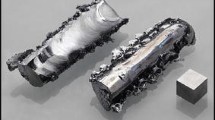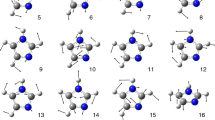Abstract
The complexes Mn(II), Co(II), Ni(II), Cu(II) and Zn(II) with 3-(anilinomethylene)-2-methoxychroman-4-one were synthesized and characterized by elemental analysis, conductivity, infrared and UV–Vis spectroscopy, 1H NMR, X-ray diffraction patterns, magnetic susceptibility and thermal analysis (TG/DTG/DSC). The X-ray analysis shows that the studied compounds crystallize in the triclinic crystal system and they are no isostructural complexes. The unit cell parameters for these chelates were presented. The molecules of solvent are in the outside coordination sphere of the complexes. The chelates have different thermal stability and they decompose in air atmosphere in three steps. The coordination of metal ions is through nitrogen atom from ligand and oxygen atom present in 4-position of γ-pyrone. The studied chelates have electrolyte (1:1) and non-electrolyte nature. They are high-spin complexes with octahedral coordination and the weak ligand fields.





Similar content being viewed by others
References
Wang BD, Yang ZY, Lu MH, Hai J, Wang Q, Chen ZN. Synthesis, characterization, cytotoxic activity and DNA binding Ni(II) complex with the 6-hydroxy chromone-3-carbaldehyde thiosemicarbazone. J Org Chem. 2009;694:4069–75.
Rybarczyk-Pirek AJ, Małecka M, Grabowski SJ, Nawrot-Modranka J. A benzopyran derivative substituted at position 3. Acta Cryst. 2002;C58:405–6.
Wang BD, Yang ZY, Li TR. Synthesis, characterization, and DNA- binding properties of the Ln(III) complexes with 6-hydroxy chromone-3-carbaldehyde-(2’-hydroxy) benzoyl hydrazone. Bioorg Med Chem. 2006;14:6012–21.
Nawrot-Modranka J, Nawrot E, Graczyk J. In vivo antitumor, in vitro antibacterial activity and alkylating properties of phosphorohydrazine derivaties of coumarin and chromone. Eur J Med Chem. 2006;41:1301–9.
Singh G, Singh R, Girdhar NK, Ishar MPS. A versatile route to 2-alkyl-/aryl-amino-3-formyl-and heteroannelated-chromones, through a facile nucleophilic substitution at C2 in 2-(N-methylanilino)-3-formylchromones. Tetrahedron. 2002;58:2471–80.
Loa J, Chow P, Zhang K. Studies of structure-activity relationship on plant polyphenol-induced suppression of human liver cancer cells. Cancer Chemother Pharmacol. 2009;63:1007–16.
Agosthina M, Matos R, Sousa C, Morais V. Thermochemistry of chromone and coumarin-3-carboxylic acid. J Therm Anal Calorim. 2010;100:519–26.
Shim YS, Kim KCh, Chi DY, Lee KH, Cho H. Formylchromone derivatives as a novel class of protein tyrosine phosphatase 1B inhibitors. Bioorg Med Chem Lett. 2003;13:2561–3.
Arjunan V, Subramanian S, Mohan S. FTIR and FTR spectral studies of 2-amino-6-bromo -3-fromylchromone. Spectrochim Acta. 2004;A60:995–1000.
Stankovicova H, Lacova M, Gaplovsky A, Chavanova J, Pranayova N. Reaction of 3-formylchromones with aromatic amino carboxylic acids. Tetrahedron. 2001;57:3455–64.
Plaskon AS, Ryabukhin SV, Volochnyuk DM, Gavrilenko KS, Shivanyuk AN, Tolmachev AA. Synthesis of quinolines from 3-formylchromone. J Org Chem. 2008;73:6010–3.
Bondyopadhyay Ch, Sur KR, Patra R, Sen A. Synthesis of coumarin derivatives from 4-oxo-4H–1-benzopyran-3-carboxaldehyde via 3-(arylaminomethylene)chroman-2,4-dione. Tetrahedron. 2000;56:3583–7.
Borrell JI, Teixido J, Schuler E, Michelotti E. Solid-supported synthetic eguivalents of 3-formylchromone and chromone. Tetrahedron Lett. 2001;42:5331–4.
Sasnovskikh VY, Moshkin VS, Irgashev RA. The first synthesis of 3-cyano-2-(polyfluoroalkyl)chromones. Tetrahedron Lett. 2006;47:8543–6.
El-Shaaer HM, Foltinova P, Lacova M, Chovancova J, Stankovicova H. Synthesis, antimicrobial activity and bleaching effect of some reaction products of 4-oxo-4H-benzopyran-3-carboxaldehydes with aminobenzothiazoles and hydrazides. II Farmaco. 1998;53:224–32.
Dziewulska-Kułaczkowska A, Mazur L. Structural studies and characterization of 3-formylchromone and products of its reactions with chosen primary aromatic amines. J Mol Struct. 2010;985:233–42.
Werner PE. TREOR, trial and error program for indexing of unknown powder patterns, University of Stockholm, Stockholm: Sweden; 1984. p. S106 91.
König E. Magnetic properties of coordination and organometallic transition metal compounds. Berlin: Springer Verlag; 1966.
Socrates G. Infrared and Raman characteristic group frequencies. Chichester: Wiley; 2001.
Nakamoto K. Infrared and Raman spectra of inorganic and coordination compounds. Toronto: Wiley; 1997.
El-Boraey HA, Donia AM, El-Samalehy MF. Preparation, characterization and thermal investigation of polymeric and monomeric binuclear complexes of dianils derived from 6-formylkhellin with cobalt(II), nickel(II) and copper(II). J Anal Appl Pyrolysis. 2005;73:204–11.
Pajtášová M, Ondrušová D, Jóna E, Mojumdar SC, L’alíková S, Bazyláková T, Gregor M. Spectral and thermal characteristic of copper(II) carboxylates with fatty acid chains and their benzothiazole adducts. J Therm Anal Calorim. 2010;100:769–77.
Ahmed IS, El-Mossalamy EH. Synthesis and characterization of oxazolone complexes with Fe(III), Co(II), Ni(II), Cu(II) and Zn(II) in different counterions. J Anal Appl Pyrolysis. 2003;70:679–86.
Sönmez M, Levent A, Sekerci M. Synthesis, characterization, and thermal investigation of some metal complexes containing polydentate ONO-donor heterocyclic Schiff base ligand. Russ J Coord Chem. 2004;30(9):655–60.
Dziewulska-Kułaczkowska A. Manganese(II), cobalt(II), nickel(II), copper(II) and zinc(II) complexes with 4-oxo-4H–1-benzopyran-3-carboxaldehyde. Thermal, spectroscopic and magnetic characterization. J Therm Anal Calorim. 2010;101:1019–26.
Rzączyńska Z, Sienkiewicz-Gromiuk J, Głuchowska H. Structural and thermal properties of rare earth complexes with 2, 2′-biphenyldicarboxylic acid. J Therm Anal Calorim. 2010;101:213–9.
Nikolaev AV, Logvinienko VA, Myachina LI. Thermal analysis. New York: Academic Press; 1989.
Paulik F. Special trends in thermal analysis. Chichester: Wiley; 1995.
Todor DN. Thermal Analysis of Minerals. Kent: Abacus Press, Tunbridge Wells; 1976.
Šumar-Ristović MT, Minić DM, Poleti D, Miodragović Z, Miodragović D, Andelković KK. Thermal stability degradation of Co(II), Cd(II) and Zn(II) complexes with N-benzyloxycarbonylglycinato ligand. J Therm Anal Calorim. 2010;102:83–90.
Chen S-P, Li N, Wei Q, Gao S-L. Synthesis, structure analysis and thermodynamics of [Ni(H2O4(TO)2](NO3)2·2H2O (TO = 1,2,4-triazole-5-one). J Therm Anal Calorim. 2010;100:1115–20.
Dziewulska-Kułaczkowska A, Mazur L, Ferenc W. Thermal, spectroscopic and structural studies of zinc(II) complex with nicotinamide. J Therm Anal Calorim. 2009;96:255–60.
Modi CK, Patel SH, Patel MN. Transition metal complexes with uninegative bidentate schiff base. Synthetis, thermal, spectroscopic and coordination aspects. J Therm Anal Calorim. 2007;87:441–8.
Omar MM, Mohamed GG, Hindy AMM. Transition metal complexes of heterocyclic Schiff base. Biological activity, spectroscopic and thermal characterization. J Therm Anal Calorim. 2006;86(2):315–25.
Mohamed GG, Omar MM, Hindy AMM. Synthesis, characterization and biological activity of some transition metals with Schiff base derived from 2-tiophene carboxaldehyde and aminobenzoic acid. Spectrochim Acta. 2005;A62:1140–50.
Burger K. Coordination chemistry; experimental methods. Budapest: Akadémiai Kiadó; 1973.
Issa YM, El-Ansary AL, Sherif OE, El-Ajiily MM. Separation and spectroscopic characterization of new metal chelates of 8-arylazo-6-formyl-7-hydroxy-5-methoxy-2-methyl chromones. Trans Met Chem. 1997;22:441–6.
Offiong E, Nfor E, Ayi A. Synthesis, spectral and cytotoxicity studies of palladium(II) and platinum(II) amino acid Schiff base complexes. Trans Met Chem. 2000;25:369–73.
El-Wahab ZHA, El-Sarrag MR. Derivatives of phosphate Schiff base transition metal complexes: synthesis, studies and biological activity. Spectrochim Acta. 2004;A60:271–7.
Doskocz M, Kubiak K, Frąckowiak A, Gancarz R. NMR and ab initio studies of Mg2+, Ca2+, Zn2+, Cu2+ alizarin complexes. Polyhedron. 2009;28:2201–5.
Geary W. The use of conductivity measurements in organic solvents for the characterization of coordination compounds. J Coord Chem Rev. 1971;7:81–122.
Hamman AM, Ibrahim SA, El-Gahami MA, Fouad D. Investigations of Co(II), Ni(II) and Cu(II) (2, 20:60, 200-terpyridine)complexes with sulphur donor ligands. J Therm Anal Calorim. 2003;74:801–10.
Chandra S, Gupta LK, Jain D. Spectroscopic studies on Mn(II), Co(II), Ni(II) and Cu(II) complexes with N-donor tetradentate (N4) macrocyclic ligand derived from ethylcinnamate moiety. Spectrochim Acta. 2004;A60:2411–7.
Author information
Authors and Affiliations
Corresponding author
Rights and permissions
About this article
Cite this article
Dziewulska-Kułaczkowska, A. Thermal and spectral studies of Mn(II), Co(II), Ni(II), Cu(II) and Zn(II) complexes with 3-(anilinomethylene)-2-methoxychroman-4-one. J Therm Anal Calorim 109, 7–15 (2012). https://doi.org/10.1007/s10973-011-1387-y
Received:
Accepted:
Published:
Issue Date:
DOI: https://doi.org/10.1007/s10973-011-1387-y




